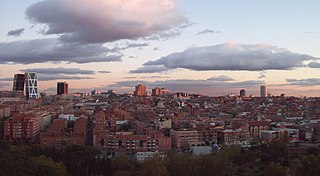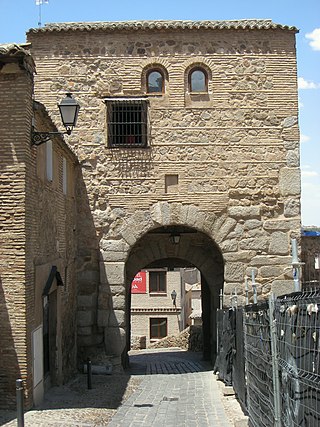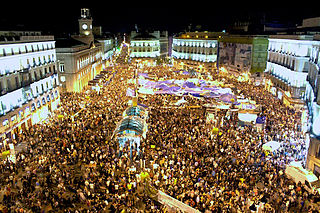
Libertad Lamarque Bouza was an Argentine actress and singer, one of the icons of the Golden Age of Argentine and Mexican cinema. She achieved fame throughout Latin America, and became known as "La Novia de América". By the time she died in 2000, she had appeared in 65 films and six telenovelas, had recorded over 800 songs and had made innumerable theatrical appearances.

The Puerta del Sol is a public square in Madrid, one of the best known and busiest places in the city. This is the centre of the radial network of Spanish roads. The square also contains the famous clock whose bells mark the traditional eating of the Twelve Grapes and the beginning of a new year. The New Year's celebration has been broadcast live since 31 December 1962 on major radio and television networks including Atresmedia and RTVE.

Centro is a district of Madrid, Spain. It is approximately 5.23 km2 in size. It has a population of 149,718 people and a population density of 28,587/km2. It roughly corresponds to the bulk of the housing formerly enclosed by the so-called Walls of Philip IV. The district is made up of the neighbourhoods of Cortes, Embajadores, Justicia, Universidad, Palacio and Sol.

Tetuán is a district of Madrid, Spain.

Romance: En Vivo is a VHS video from Mexican singer Luis Miguel that was recorded in 1992 during the concert tour called Tour Romance that Luis Miguel perform in various places like Caracas, Venezuela, in the Circus Maximus Theatre in Las Vegas, Nevada, in a concert in Seville, Spain, and in the National Auditorium in Mexico City, where he broke the World Record by selling the 10,000 tickets for his only show in 3 hours.

The Puerta Bab al-Mardum, or Puerta de Valmardón, is a city gate of Toledo, Spain. It was built in the 10th century and is one of the oldest gates in the city. Its name 'mardum' is Arabic for 'blocked up'. Perhaps because its function was taken over by the Puerta del Sol. The Spanish name Valmardón is a rough, phonetic imitation of the Arabic. 'Mezquita Bab al-Mardum' is another name for the nearby Mosque of Cristo de la Luz.

Puerta del Sol is a city gate of Toledo, Spain, built in the late 14th century by the Knights Hospitaller.

Sebastián is a Mexican sculptor best known for his monumental works of steel and/or concrete in both Mexico and abroad. These include a number of “gate” sculptures such as the Gran Puerta a México in Matamoros, Tamaulipas but his most famous sculpture is the “Caballito” located in downtown Mexico City. His works are found in various countries outside Mexico, such as Japan where two are now used as city symbols.
Since the foundation of the New Kingdom of Galicia, the Mexican state of Jalisco has established itself as a main hub in the national economy and as the business centre of the western portion of the country. Although its economic strength is mainly concentrated in the capital, Guadalajara, the rest of the state enjoys a growing prosperity in diverse economic areas. Forest products are obtained along the coast, and mining for silver, gold, mercury, copper, and precious stones is an important activity. The beverage tequila, distilled from the juice of the agave cactus, is named for the town of that name in Jalisco and is one of the state’s best-known products. Since the state is home to two UNESCO World Heritage Sites, tourism is an important economic engine. In 2006 20 million local and international tourists visited the state, contributing to an economic revenue of 25 billion pesos, 11% higher than in 2005. Guadalajara is served by one of the country’s busiest airports and is one of the state’s major tourist centres. Puerto Vallarta is a popular tourist destination among young students. The state ranks number three in terms of nominal GDP behind Nuevo León State. Since the adoption of the North American Free Trade Agreement (NAFTA) in 1994 the state has been experiencing a high rate of investment. Jalisco, like many other industrial states in the country, has evolved from a producer of cheap, low-quality goods into an exporter of sophisticated products, from auto brake systems to laptop computers. 86% of the population is urban, higher than the national average of 76%.

¡Democracia Real YA!, also known as Plataforma Democracia Real Ya!, is a Spanish grassroots organization that started in March 2011 in Madrid, Spain. It sparked the political movement of May 15, 2011 (15M) whose protests gained worldwide attention. The protests been compared to the May 1968 social movement in France.

The anti-austerity movement in Spain, also referred to as the 15-M Movement, and the Indignados Movement, was a series of protests, demonstrations, and occupations against austerity policies in Spain that began around the local and regional elections of 2011 and 2012. Beginning on 15 May 2011, many of the subsequent demonstrations spread through various social networks such as Real Democracy NOW and Youth Without a Future.

The now defunct Convento de San Felipe el Real was a former Madrilenian convent of Calced Augustinian monks, located at the beginning of Calle Mayor in Madrid, next to the Puerta del Sol. Built between 16th and 17th centuries, was rise on a large pedestal, was part of it a famous talking shop of the city. One of its famous guests was Friar Luis de León. It was opposite the Palacio de Oñate.

The Iglesia de Nuestra Señora del Buen Suceso, commonly known as Iglesia del Buen Suceso was a church of Madrid that delimited the eastern part of the Puerta del Sol (Madrid). The church comes from a remodeling of the Hospital Real de la Corte. Was doing functions of church and hospital since 1590. Its lonja was meeting place for several centuries. The church's clock would be important during this period until it was installed one of better performance on the Real Casa de Correos. Its demolition coincided with the Confiscation of Mendizábal that left space for the later expansion that was done for the Puerta del Sol.
The Walls del Arrabal were the third in a set of five walls built around Madrid, now the capital of Spain. There are no remaining ruins of the Walls del Arrabal, leaving some debate as to their extent and the period of their construction. It is possible that the walls were built as early as the 12th century, however they were most likely constructed in 1438. The walls may have been intended to protect people against the plagues that ravaged the city at the time. The walls united the urbanized suburbs of the city and prevented entry of the infected.

The Fountain de La Mariblanca was a fountain located in Puerta del Sol, in Madrid. Now demolished. Not to be confused with other fountains located in Madrid and Spain with the same name.

The Alarcones Gate is a city gate located in the city of Toledo, in Castile-La Mancha, Spain. It is also known by the name of Puerta de Moaguía, as cited in Mozarabic documents of 1216; and Puerta Alta de la Herrería, because it is located at the end of the street where workshops dedicated to ironworks were located.
La Puerta del Sol, translated as The Gateway of the Sun, is one of the largest sculptures in Chihuahua, Mexico. It is also known as The Gateway of the Obelisks.
Ruta de la Amistad is a sculpture corridor in Mexico City located along the southern section of the Anillo Periférico highway. The route was inaugurated in 1968 as part of that year Summer Olympics, has a length of 17 kilometers and nineteen sculptures by artists from seventeen countries.

The history of the Puerta del Sol represents an essential part of the memory of the Villa de Madrid, not only because the Puerta del Sol is a point of frequent passage, but also because it constitutes the "center of gravity" of Madrid's urban planning. The square has been acquiring its character as a place of historical importance from its uncertain beginnings as a wide and impersonal street in the sixteenth century, to the descriptions of the first romantic travelers, the receptions of kings, popular rebellions, demonstrations, etc. It has been the scene of major events in the life of the city, from the struggle against the French invaders in 1808 to the proclamation of the Second Republic in 1931, and it has also retained its place as the protagonist of the custom of serving twelve grapes on New Year's Eve, to the sound of the chimes struck by the Correos clock. Nowadays it is a communications hub, a meeting point, a place of appointments, a place for celebrations and the beginning of demonstrations in the Capital.

Kanasín is a city in the Mexican state of Yucatán and the municipal seat of the municipality of the same name. It is located in the northwestern region of the state, forming part of the Mérida metropolitan area. According to the 2020 census carried out by the National Institute of Statistics and Geography (INEGI), it had a population of 139,753, making it the second largest Yucatecan city after Mérida, the 8th most populous in southeastern Mexico and the 101st most populous in the country.















